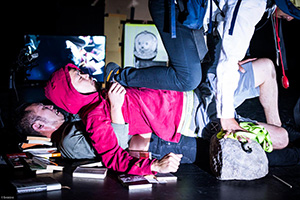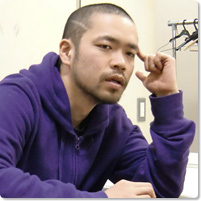Concerning the performance venue
There are no restrictions on the type of venue used as long as the lights can be turned off to make it completely dark.
However, a space of at least 30 meters square is necessary.
The performance should to be viewed from the front; the audience should not be positioned to view it from the side or rear.
Concerning the performers
The cast consists of four performers (hereafter designated A, B, C and D) are divided into four roles. There are no restrictions on their age or gender. As a basic stance, the performers should approach the performance as a task rather than a form of self- or artistic expression (be aware that using performers with previous training in dance or acting may be a detrimental or troublesome in final execution of the performance). Efforts should be made to use amateur performers with no previous training. Rather than extroverted people, preference should be placed on choosing people who are reserved or introverted (SPP = Silent Party People). Also, it is necessary that the four performers get to know each other before the performance. There is a need for them to go hiking in the mountains together (at which time they should gather a rock that will be used in the performance). It they are originally from the countryside, there is a need for them to come to the city together and experience sleeping in parks or in alleys between buildings [like urban homeless].
Things for the individual performers to prepare
[Preparations for performer A]
Costume: Slim-fitting trousers (black in color), long sleeved sweatshirt (khaki color), knit cap (black), skate shoes (black)
Props to bring: A handful of nuts and bolts, a pair of wooden chopsticks (one), wristwatch with alarm function
[Preparations for performer B]
Costume: Slim-fitting trousers (black), long sleeved shirt, slim-fitting sweater, cardigan, shoes with minimum protrusions on the sole (relatively smooth sole)
Props to bring: A rucksack full of books from a variety of fields (they must be books that performer B has read), a BMX bicycle rear wheel (if one can’t be found, anything similar that can be rolled), rope, a beverage
[Preparations for performer C]
Costume: Red clothes, soccer pants, sneakers, ankle socks, cap (whether it is worn or not to be decided on the scene)
Props to bring: A rock (10-12kg)
[Preparations for performer D]
Costume: White T-shirt that performer D draws a picture on
Props to bring: A musical instrument (any kind except one that performer D is skilled with), a camera with flash (Preferably Fuji Film “
Utsurundesu
”1600Hi Speed if it is being sold)
Concerning overall pre-performance preparations
Do as little rehearsing as possible.
Instead, use that time and money all for eating some delicious food.
Try to use everyone’s lack of technical skills to your advantage and treat it as a kind of strength.
Be sure everyone has health insurance.
Concerning setup of the performance space
Make the place where performer A will lie on the floor the center of the performance space. (A will lie down in the center of the performance space) A will lie with his/her head to the left when seen from the audience.
A personal computer a web camera are used to take video images from above of the face of performer (A) lying on the floor face-up and relay it to a television screen in real-time.
At A’s feet a drum is placed (a tam drum is a possible substitute).
Behind the place where A lies, a cardboard house [like those made by the homeless] measuring 1.2 meters square is placed.
This cardboard house is made by performer D at the performance venue beforehand.
The lighting and the sound equipment is set up by the four performers.
If the performance space, including the audience space, is smaller than a 15-meter square area, no sound amplifying equipment is necessary.
If the space is larger the 15 meters square, use two microphones to amplify the voice of A and the sound of the drum.
The lighting should basically be white light and it should be set up so that it can all be turned off with one switch. If the performance venue is a regular room someplace, the room’s normal lighting should be used.
Performance order of events
Performer A lies down on the floor.
When this happens an alarm set to go off in fifteen minutes is started.Next B steps on A and stays standing on him/her [so that A bears B’s weight].
Ten minutes later C gets on [applies his/her weight to] A carrying the rock.
Until that time, C may be stand beside or near A and B holding the rock.
B and C continue to apply their full weight to A while making an effort not to fall off.
Until this point, D has been waiting in the cardboard house behind, when the lights are turned off and the performance space goes dark, D comes out of the house with the instrument he/she has brought and begins to play it.
Also, while playing the instrument in the dark he/she uses the camera to take pictures of himself/herself using the flash.
When the lights come back on he/she returns to the cardboard house.
The lights are turned off by B based on his/her judgment after A hits the drum with a nut or bolt.
After a while, on his/her judgment, A sneezes and this becomes the signal for B to turn on the lights again.
B and C must choose parts of A’s body to step on that are physically stressful/painful, but at the same time they must be careful not break weaker bones in A’s body, like the ribs, sternum or collarbone.
Also, they must not step on the boneless area of the stomach area where they would be applying pressure directly to the inner organs.
They all use the props they bring to the performance to interact with each other.
When the alarm that A has set goes off [after 15 minutes] they make an effort to move as they are [in the same posture/positions] to the cardboard house behind them.
At the sound of the alarm, D comes out of the house and sounds his/her instrument.
When the timing seems right, D turns out the lights and the performance ends.
The ending should come no more than five minutes after the alarm sounds.
The entire performance should be conducted in silence without any words spoken.
©contact Gonzo
This is the first work of contact Gonzo’s new “physics series, and plans are for it to be followed by sequels “Choreography Concept 002 for untrained amateurs / Study in speed and movement” and “Choreography Concept 003 for untrained amateurs / Study in angle and movement.



